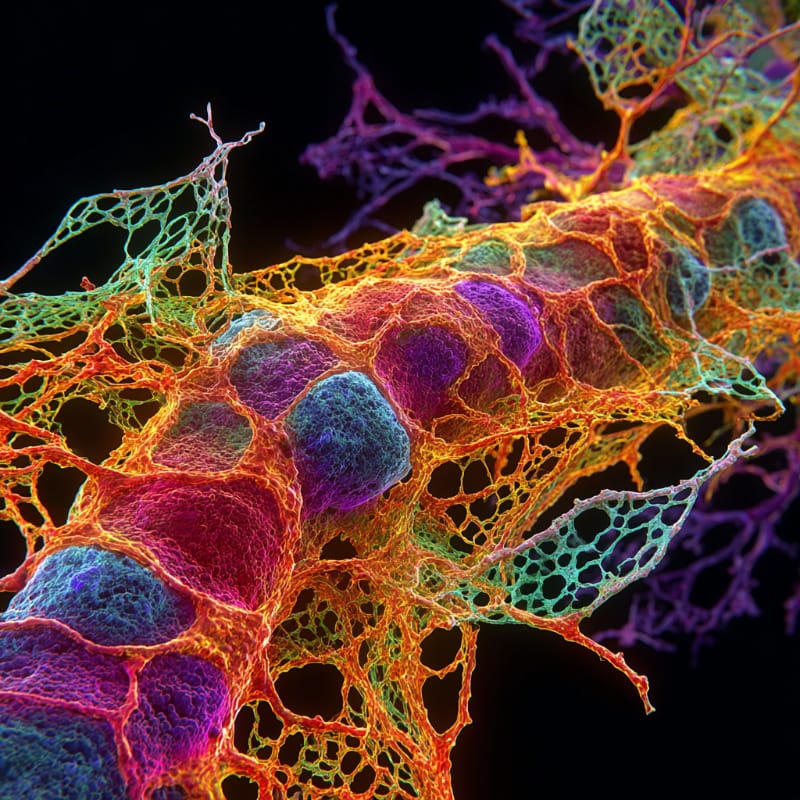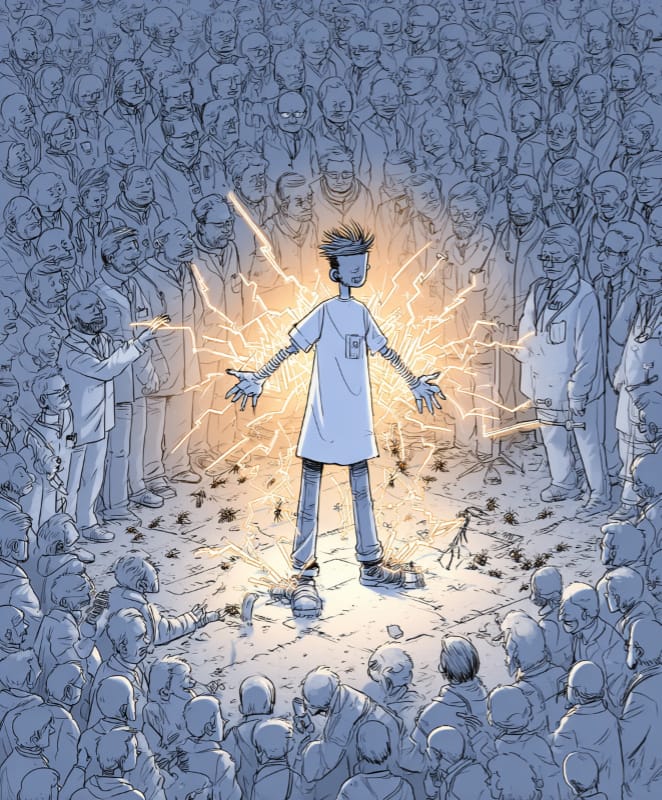- Cidpedia
- Posts
- CIDPedia "I Want A Cure"
CIDPedia "I Want A Cure"
Special Issue "I Want A Cure" #3 06/21/2025
🌟 Central Texas Resource
ALWAYS FRESH - Start your week empowered - updates, resources, and encouragement await!
Trusted Information and Community for Patients, Caregivers, and Professionals
www.cidpedia.net

Damaged Myelin with Nerve Debris
Editor’s Note
Welcome to Issue #3 of our “I Want a Cure” series, where we peel back the curtain on the true beginnings of scientific exploration. Most research programs begin with big questions, small teams, and a labyrinth of logistical and ethical considerations. Over the next eight weeks—each representing one “year” in an accelerated, fictionalized journey—we will try to demystify the process and spotlight both victories and setbacks in real-world terms.This series of articles was a hard decision knowing what the REAL outcome of our project would have to be. Getting educated hurts sometimes.
This issue focuses on Year 1, a pivotal phase where ideas take shape and infrastructure is built. Remember, this narrative is entirely fictional and crafted solely for educational purposes. All concepts are drawn from publicly accessible knowledge about how biomedical research operates, and no special insider information is required to understand or engage with this material.

Week 1 (Year 1) of CIDP Research: Building Our Dream Team
Think of starting a research lab like building a barn – you need the right people, the right tools, and a solid plan. This week, our made-up Phoenix Peripheral Neuropathy Research Institute is getting ready to tackle CIDP, and we're going to walk you through it like we're sitting on the front porch and talking.

Our Team
1. 👥 Our Research Family: Who's Doing What
Just like any good project needs different kinds of folks, our research team brings together people with different skills – kind of like how you need a carpenter, an electrician, and a plumber to build a house right.
Dr. Elena Carter (The Boss ) 🧑🔬
She's like the foreman of our operation – been studying nerve problems for 15 years and knows how to work with big organizations like the government to pay for our work.Dr. Marcus Nguyen (The Body's Defense Expert) 🔬
Think of him as our detective who figures out why the body's own security system (immune system) sometimes attacks the good guys (our nerves) by mistake.Dr. Amara Singh (The Nerve Tester) ⚡
She's our electrical expert – nerves work like the wiring in your house, and she knows how to test if they're working right or if something's gone wrong.Mr. Luis Torres (The Keeper of Everything) 🛠️
Every good operation needs someone who makes sure we have what we need when we need it – he's like the supply sergeant who keeps everything running smooth.Ms. Sara Patel (The Patient Voice) 🤝
She's the bridge between us science folks and real people living with CIDP – makes sure we never forget why we're doing this work in the first place.

Is This New?
2. 🎯 What We're Trying to Figure Out
Imagine CIDP like termites eating away at the insulation around electrical wires in your house. We want to understand three main things:
2.1. How Does This Happen?
We're going to study how the body's defense system gets confused and starts attacking the protective coating around nerves (like termites eating wire insulation). We'll look at tiny cleanup cells called macrophages that normally eat up bad stuff but start munching on good nerve coating instead 🔍.
2.2. Can We Spot It Early?
Just like checking your house for termite damage, we want to find signs in blood tests that show nerve damage is happening – even before you feel it. We're looking for two things:
Nerve debris (like finding wood shavings that show termites have been busy)
Inflammation markers (like finding the termites themselves)
2.3. Better Ways to Test Nerves
We want to create a standard way to test how well nerves work – like having a reliable method to check if all the electrical outlets in your house are working properly ⚡.

On It
3. 📅 This Week's To-Do List
📚 Read Everything We Can
Like researching before you buy a car, we're reading every study about CIDP to see what others have learned. Turns out, only about 1-9 people out of every 100,000 have CIDP.📋 Get Permission to Study People
Before we can work with patients, we need approval from a committee that makes sure we're being safe and fair – like getting a building permit before you start construction.🛠️ Buy Our Tools
We're getting fancy equipment:A machine to test nerve signals (like a really good electrical tester)
Equipment to analyze blood samples
A super-cold freezer to store samples for later

I Walk This Path
4. 💡 Why This Matters
For Patients Like You
CIDP is like having your house's electrical system slowly failing. If we catch it early and understand it better, we can:
Fix problems before they become permanent (like catching termites before they bring down the house)
Find better treatments for people who don't get better with current medicines
Keeping Patients First
Everything we do has to make sense to real people dealing with CIDP. We're not just looking at numbers – we're thinking about helping folks get back to doing what they love, whether that's gardening, playing with grandkids, or just walking to the mailbox without worry 💜.

Should We?
5. ⚖️ Playing by the Rules
Getting Permission
We have to get approval from a special committee before we can work with 150 people who have CIDP. It's like getting your plans approved by the city before you build – lots of paperwork, but it keeps everyone safe.
Keeping Information Private
All patient information gets locked up tighter than your grandmother's secret recipe – we use special computer systems that keep everything secure and private 🔒.

By The Book
6. 🏭 Setting Up Our Workshop
Think of our lab like a well-organized garage workshop:
What We Have | What It Does |
|---|---|
Nerve Testing Room | Like having a good electrical meter to test house wiring |
Blood Analysis Station | Like having a chemistry set to figure out what's in samples |
Super Cold Storage | Like having a deep freezer that keeps samples fresh for years |
Computer System | Like having really good filing cabinets that never lose anything |
How We'll Work:
Patient comes in → Doctor examines them → We take a small blood sample → Test their nerves → Put everything in our computer → Store samples safely for later study

Simple Right?
7. ⚠️ What Could Go Wrong (And How We'll Handle It)
Problem | Our Solution |
|---|---|
Hard to find patients | Work with patient groups to spread the word |
Different people get different test results | Train everyone the same way, like teaching all mechanics to change oil the same way |
Paperwork delays | Start early and ask lots of questions upfront |
Money runs out | Have backup plans and keep looking for more funding |

Community
8. 🤝 Working Together
Patient Groups: We meet monthly with people who have CIDP to make sure we're focusing on what really matters to them
Hospital Partners: We're working with three different hospitals to find patients who want to help with research
Money People: We keep the folks who gave us money updated on how we're spending it responsibly

Funding
9. 💰 Where the Money Goes
Like any household budget, we have to be smart about spending:
People's Salaries: 60% (biggest expense – good people cost money)
Equipment: 20% (tools to do the job right)
Finding Patients: 10% (spreading the word)
Number Crunching Help: 10% (making sense of all our data)

A Plan
10. 🚀 What's Next
This first week is like laying the foundation for a house – not very exciting to watch, but absolutely necessary for everything that comes after. We're setting up systems, getting permissions, and making sure we have everything we need to do good science.
Coming Up:
Week 2: We start testing our methods on small groups (like trying a new recipe on family before serving it to company)
Future Weeks: Building on what we learn, step by step, toward better treatments and maybe even a cure
Remember, this is all made-up to help you understand how real research works. But somewhere out there, real scientists are doing this exact kind of work, taking these same careful steps, all in hopes of helping folks with CIDP live better lives.
Next week, we'll see how our team handles their first real experiments – the successes, the failures, and the surprises that make research both frustrating and exciting! 🌟
Sources: All the information in this article comes from publicly available research about how medical studies work. No secret knowledge required – just curiosity and patience to understand how science really happens.
📅 Closing Thoughts & How to Get Involved
Take advantage of these articles if you can, ask questions, and share what works for you. Together, we’re building a stronger, more informed CIDP community.
Want to support Cidpedia.net ?
Share this article, consider a small donation, or send us your feedback. Every voice matters.
Stay strong, stay informed, and stay connected!
Warm regards,
Richard Aikman
Editor, CIDPedia
⚠️ Disclaimer
Let's get something important out in the open: WE ARE NOT DOCTORS and WE ARE NOT GIVING ADVICE! Everything we share comes from my personal journey living with CIDP, from research and from MY healthcare TEAM. While I've walked this path for a number of years, please remember: This content is based on personal experience and publicly available information. It is not intended to diagnose, treat, cure, or prevent any disease. Always consult qualified healthcare providers for medical advice, what works for others may not work for you. |
We respect your privacy and adhere to HIPAA guidelines when sharing stories or community contributions. All shared experiences are anonymized unless explicit permission is granted |
Stay strong, stay curious, and keep shuffling forward. 🌱

Reply